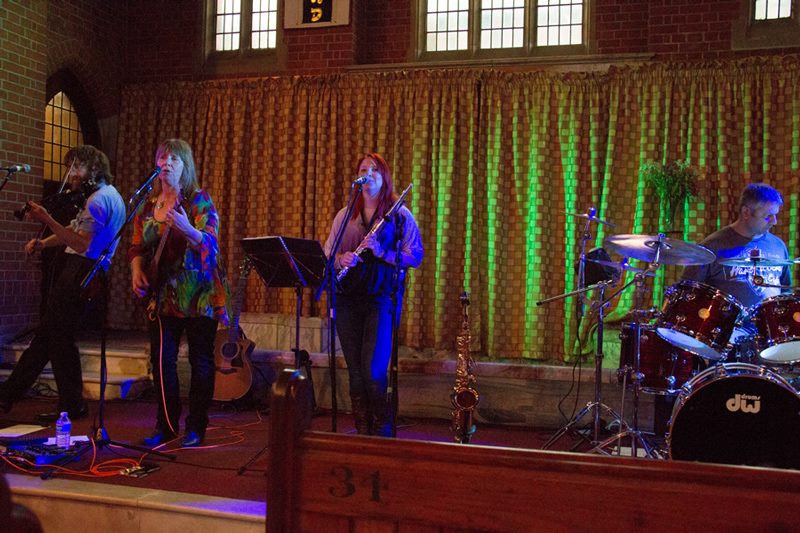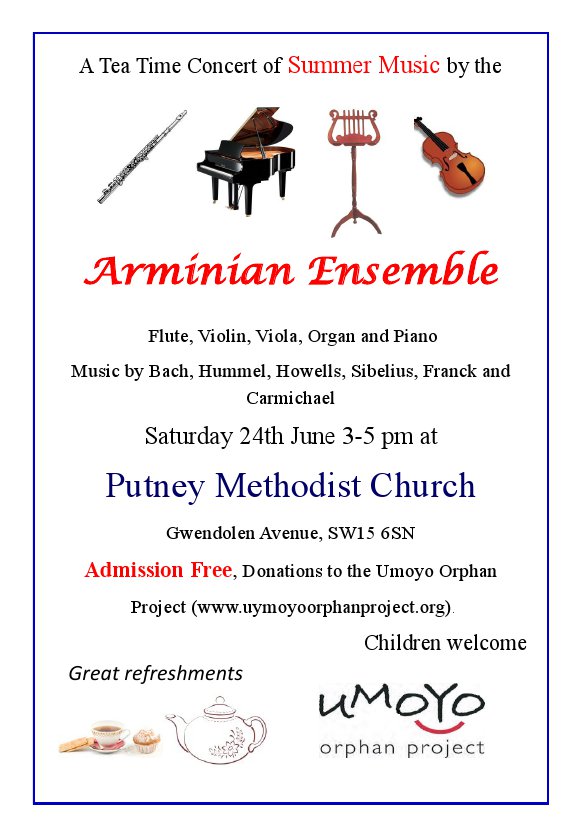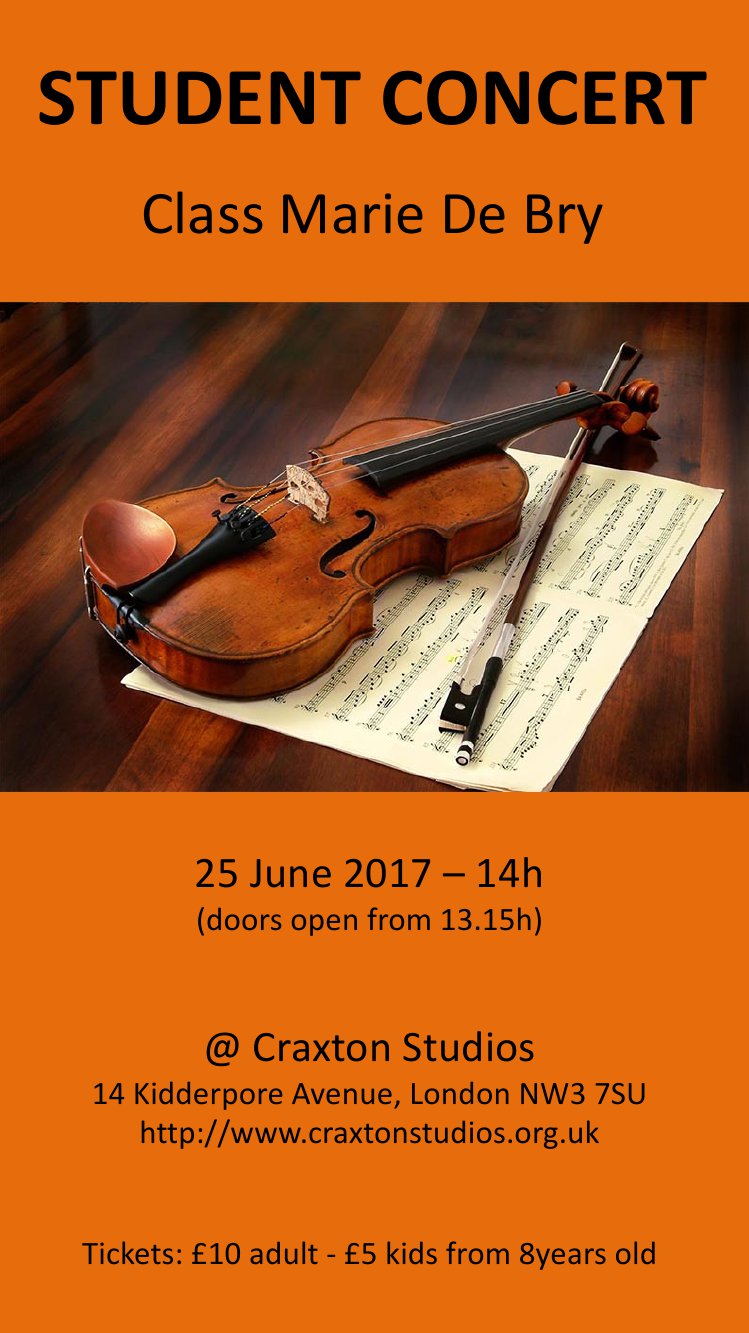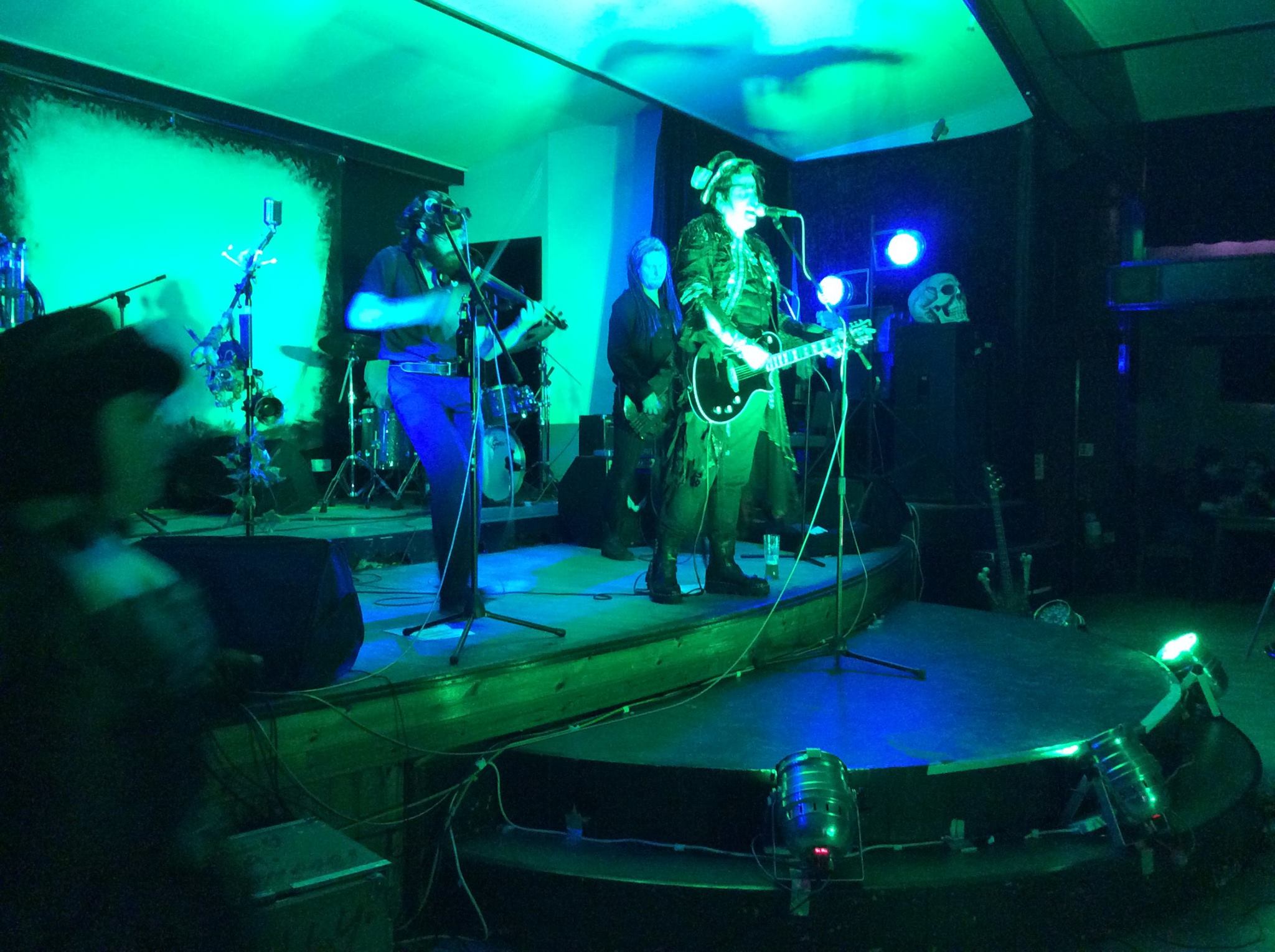And I may or may not make inconsistent attempts to punningly link disparate observations from a day’s playing back to an eye-catching headline.
On Sunday, I was swelling the ranks of St Giles Orchestra’s violas again – and if anything with rather more need than last time, since we were four in total. That might have balanced about right with the two double basses, but was underpowered to the five cellos let alone the serried ranks of violins I didn’t try to count, and is definitely on the low end for balancing the wind and brass scoring of Bizet (first Carmen suite) and Dvorak (fourth symphony).
The event was not a conventional concert though. It was a conducting masterclass – so primarily a training event for young aspiring conductors. Of course, one can only do a quite limited amount of training conductors without an actual orchestra for them to conduct, and so we were acting as, perhaps, the clay on the wheels of these trainee potters (adjust metaphor to taste). Perhaps unsurprisingly, it also had a competitive element, to which I shall return later. I’m unsure that education and competition are as good bedfellows as some contemporary praxis might suggest, particularly (as in this instance) where the participants are at wide-ranging levels of experience and commitment to the craft. An emphasis on a winner in (almost inevitably) terms of level of ability demonstrated draws attention away from progression, perhaps the only metric that could fairly be applied across the board here. Further, if someone has ‘won’, can they therefore stop learning? If someone has ‘lost’, do they see the day as a failure rather than assessing what they learnt and how much better they got? There is incidentally a subtle difference here between assessing for a qualification – which is, at least in principle, an objective, transferable, constant level of skill which can be used to indicate whether one is equipped for such and such an opportunity, essentially – and judging a winner from a field – which indicates the best of those present without any necessary objective benchmark, and so is or should be a much less used indicator of ability thereafter.
In any case. Four teenagers got to use movements of the Carmen suite as test beds for relatively (in at least one instance totally) novice efforts in conducting. Some showed genuine expression; some had at least a very clear and followable beat; one I am sorry to say looked a little like he had changed his mind about wanting to be there, but I’m no mind-reader. The others certainly had intent and progressed markedly in their bare half-hour’s coaching and a performance of their movement at the end of the day. From the orchestra’s point of view, the material provided about the right level of musical challenge to work with these inexperienced conductors – the individual parts are sometimes difficult (solo woodwinds mostly, particularly the oboe – St Giles are very fortunate in their principal oboist, Matthias Winkler) but the ensemble fit has only occasional corners where the performance will really stand or fall on the conductor’s work, though of course good conducting can make it much better.
Particularly in this first half, where more time was spent on coaching and less was needed on running through the movements, I found it fascinating to watch Peter Stark, the ‘master’ of the masterclass if you will, at work as a teacher. (He is also an excellent conductor, but I spend a lot more time with conductors than tutors, particularly of conducting!) Conducting, perhaps like teaching, is a craft and role I am more inclined to avoid than pursue, but for any musician who is going to be conducted on a regular basis it cannot be other than helpful to know more about it. How one goes about teaching is of course widely varying and individual, and depends on the context and the subject matter and so on and so forth. One consequence of this situation was that Stark was simultaneously giving individual pointers to the conductor currently having their half-hour – and also projecting general summaries of this to the rest of the group of eight, who were sat at the back of the stage throughout. It says something for his ability as a teacher that I cannot recall him having to make the same point to two different people.
Teaching an individual, as this mostly is, of course allows a closer engagement with their individual response. One can take hold of the wrist or elbow and guide the shape of a beat; converse directly if briefly; and so on. And of course what one does next is targeted to the weaknesses, and the strengths, of the pupil. But there are some other things that struck me.
One is that above a certain level, the role of physicality seems to be re-accepted into art music training (this does not only apply to the conducting workshop under discussion). Whereas it is almost all about sound, with a perhaps rarefied reverence for the purity of musical art, in a certain middle territory, if one advances to the level perhaps of those who train future or would-be professionals then the embodiedness of musicians comes back into the picture. Of course, conductors do not actually make any noise; while actually conducting, their role is essentially entirely gestural (hands; body language; facial expression; but all gesture) and this leads to a more physical understanding of technique; perhaps. But a conscious division of labour between baton, face and body; instructions on handling tempo by using more or less length of the arm; literally standing with one’s hand outstretched to be struck from underneath in order to make a double point about all beats being ultimately upwards (interesting! ban the word ‘downbeat’ – quite a drastic suggestion for orchestral circles) and about a moment of much greater acceleration at the point of the beat itself – this to me correlates rather closely with my current viola teacher’s insistence that posture and body language are not merely a question of avoiding damping the instrument’s vibrations, or of avoiding later life back trouble, but can actually create the impression of more volume than the instrument will in fact project, and that looking confident and performative will improve the sound beyond what is explicable in simple acoustic terms. (I have had to start wearing shoes I can stand on tiptoe in to my viola lessons, for purposes of fortissimi!)
Returning to chronology. Three university students and one decidedly precocious sixth-former each had a movement to handle of Dvorak’s fourth symphony. Whether the division into two groups was entirely fair to the distribution of conducting abilities I’m not sure – I think it probably was; but certainly this was a massive step-change in demands.
I have never otherwise played or heard in concert any of Dvorak’s symphonies except the last two, the eighth and ninth. He famously disowned the first four, hence why some old copies label the ‘New World’ as his fifth, confusing the issue. However, the earlier symphonies are very rarely performed. Having played the fourth, I perhaps have a glimpse of insight into this. It is not significantly less ambitious than the later symphonies – purely on grounds of length, the first two movements clock in over ten minutes long each (this will indicate the difficulty of coaching conductors having only half an hour to work on each movement!), and the architectural desire of a grand scale, if that phrase makes any sense, is similar. It could be argued that the last two symphonies are slightly more successful – more varied, perhaps, in their final output, where there can be a sense of overkill to some of the fourth. But I would not want to overstate this – few composers have written post-Beethovian, grand-scale symphonies as successful in their goals as this one is in its pursuit of musical expression of Burke’s sublime (a minor key symphony from the mid-nineteenth century is almost always seeking after the terrible, more than the beautiful) as early as opus 13. My suggestion is simply that the earlier Dvorak symphonies are rarely heard because their musical goals are too similar to the later, very slightly more accomplished, ones. The symphonies of Beethoven, to take an obvious contrast, set out to do wildly varying things in widely varying ways; the only ones that are felt to end up overlapping or in competition with each other are numbers 1, 2, 4 and 8, and even this might be held to be a misprision or oversimplification.
In any case, returning to conducting. This presented much more real musical (and, for most players, playing-of-notes) challenges to both conductors and orchestra than the Bizet. At an obvious level there are tempo changes indicated and implied, pauses to be negotiated, balance of parts to be kept when there is more to it than tune and accompaniment. There is also the question of how to create variety and structure within a movement that may last 11 minutes and have a couple of dozen ff markings; and of creating, where appropriate (arguably for most of the three fast movements), that now rather unfashionable projection and indeed adulation of intense negative emotion that goes with Romantic art.
Much less of the tuition was about straightforward directing technique at this level of course. Ironically one moves largely from how to conjure forth something from players – to the question of what should really be requested, and how one makes aesthetic decisions of that nature.
Minefields abound in discussions in which the terms of reference may include the creative arts, gender, and different kinds of emotion. But at some point I have to bring up, if only in token protest, a significant point about this workshop, which is that the young woman who conducted the first movement of the Dvorak was the only female participant out of eight. Sadly, this is still all too indicative of the situation in conducting, particularly orchestral conducting, in general (I probably play under woman conductors less than one-eighth of the time in fact); something which I have commented and speculated on at length in another post and so will not return to here.
Nonetheless, it cannot but be ground of speculation to wonder what difference it would make if around half of conductors (not necessarily at top-flight professional level either) were women – whether, factoring in cultural gender specifics in the postmodern West, this would lead to a change in the as it were sign language used between conductors and players (the orchestral players are increasingly well gender balanced, with some specific instruments exceptional but not as badly so as rock instrumentalists), or even to some aspects of the music sound. It is all too familiar, perhaps, that in this instance the key piece of feedback from Peter to Gabrielle was to engage more vigorously with the intensity and the negativity of some aspects of the movement – more grit, as it were. And with any sense of the cultural history of post-Enlightenment Europe, one cannot do otherwise and successfully render Dvorak (nor, let me hasten to add, such female composers as Clara Schumann or Amy Beach – the women creators of the time certainly did not allow the men monopoly over the ‘sublime’, whatever some male theorists may have sought to command). However, I would wish to record that, to me, the single most noticeable instance of a change in conducting technique over the day was the extra call to intensity in the performance of this movement compared to the rehearsal – it could certainly have gone further, but the change was striking even having heard it being requested.
One last aspect of this day’s playing has little to do with conducting, though something to do with the moody power demanded of his orchestra by Dvorak, and is responsible for the title (apart from all sorts of dreadful low-Freudian implications about batons and female conductors). I came back from a break towards the end of the day, having left my viola on my chair, to find my section leader holding it up against hers. It took me a moment to realise what she was doing, but it may take a little longer to explain for anyone reading this who is not very familiar with the viola.
The violin and the cello are more or less ideally constructed, in terms of projection, for their pitch and playing with a bow. In other words, I am assured that a bigger-bodied violin, or a cello with a longer scale length, would not actually be heard more clearly. The viola as we normally know it is not constructed in the same ratio to its range; it is essentially undersized. It is possible to create violas in the same proportions, but they are too long to reach the end of the neck with the instrument under the chin, and the notes are too far apart to play with the conventional two semitones to a finger of viola technique. Those who play them (including one player with St Giles, whose extra power was significantly missed on Sunday) hold them upright, on a long cello spike, on top of or between the knees, and use something more like a cello fingering pattern, with many more changes of hand position. The result is certainly louder, but arguably does not sound quite like a viola – the different set of correspondences leading to a normal behaviour that is part of listeners’, and indeed players’ and composers’, expectations (compare the degree to which an electric guitar amp is expected to distort the input signal because ‘that’s what electric guitar sounds like’).
In any case, the conventional viola exists in a land of compromises, in which there is a tacit agreement that a bigger body would be desirable (no sniggering at the back there), but the main constraint is what an individual player can actually comfortably perform on. While there are variations in the ratio of body width to body length, and probably lesser ones in neck length to back length, the standard metric for comparing violas is the back length (excluding neck) in inches, in practice to the nearest half an inch. The standard range appears to 15 to 16.5 (giving a choice of four sizes), though I am sure I have come across as small as 14.5 and as large as 17. (For comparison, the ‘correctly proportioned’ instrument mentioned above has a back length of 20.5″.) Unsurprisingly, there grows up a perception that large violas are straightforwardly more powerful and gritty, and smaller ones both quieter and of a more soft and muted sound. Equally unsurprisingly to anyone who has any experience dealing with stringed instruments, there is in fact a great deal more to it than that and the length principle may be much less important than other factors of construction – there is after all huge variation in the volume and sound of violins, some of which can be changed on the same violin by altering apparent minor factors of setup (I posted about this recently), and all of which take place within instruments that are an almost exactly standard size.
What Judith was doing, then, was using her viola as a measuring-stick to get a sense of the back length of mine; almost certainly, from the way in which she commented on the result, to see if it was on the larger end, having been able to hear me projecting significantly during louder passages. (There were only four violas, remember, so her left ear was probably only four feet from my soundholes, and there were not that many sound sources to disentangle.) For the record, my viola appears on application of a tape measure to have a back length of 16″; so large, but not the top end of the normal range. I would suggest it does punch above its weight for this sort of context – it is probably a ‘better’ instrument than many being played in amateur orchestras, and certainly inclines to the loud and gritty – which is of course not always a good thing; it requires extra work to produce a really effective singing piano on it. However, I would go further and suggest that, again in the context of an amateur orchestra viola section, the extra power that had caught Judith’s ear (herself I am told an ex-pro, by the way) is as much to do with the technique being brought to bear by training at diploma level with a teacher who only recently left a conservatoire Master’s degree programme, as it is to do with the instrument itself. Perhaps, to resume awkward cliché where the title left off, size matters less than what you do with it.
This has become a long and rather dense read on a long and decidedly hard work day – but the day was at least fulfilling and interesting. Expect shorter write-ups of small-forces Bach in Chichester and Mendelssohn oratorio in Lincolnshire this coming weekend, and of choral and orchestral music in the Channel Islands the weekend after (though the travails of organising transport to and from that event might warrant a post to themselves). And keep your eyes peeled to a return to rock band gigging after what feels like a very long pause!




